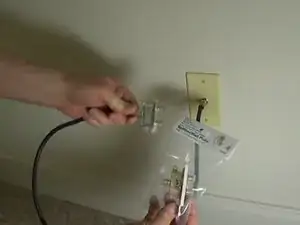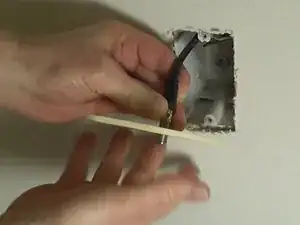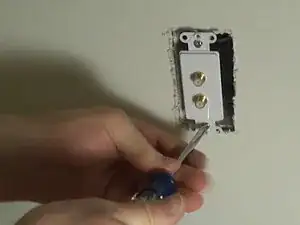Introduction
Wall outlets for electricity had only a single socket when first introduced in 1930s America. Those evolved to the double-socket or duplex outlet wall plates we now take for granted. Had they not evolved, we would all have extension cords coming from the single sockets to split the incoming electricity, just as connector cables (with splitters) still split the incoming broadband cable signal today. Now more than forty years old, the cable TV industry is evolving to duplex style wall plates for its customers' incoming cable signal.
Tools
-
-
...you know the old school setup, a connector cable coming out of the wall attached to a splitter—both lying on the floor collecting dust.
-
Unscrew the cable extension from the wall plate; you're not going to need it after this.
-
-
-
Use an appropriate screwdriver to remove the wall plate mounting screws. This wall plate used flathead screws, but yours could be Phillips.
-
-
-
Install the outer wall plate and tighten the mounting screws with the appropriate screwdriver.
-
Enjoy your reclaimed floor space and futuristic wall plate!
-
3 comments
I already have a wall plate with one cable output(for my modem) can I connect the splitter to this wall plate or I have to remove the plate and connect the other cable behind the wall plate
The reason why coaxial wall plates only have one coaxial jack is because using a two-way splitter divides the signal by two. That’s right, the signal strength on both sockets is 50% weaker. It doesn’t matter whether there is something connected to the other socket or not, or what’s connected to it, it’s still half as strong as it was before the splitter on both sockets. In fact, leaving an unused socket open is even worse as it let interference in. Coaxial works with a center conductor that carries the signal, and an outer shielded that protects against EMI and it needs to be sealed (i.e., no open jack, unconnected cable, cut cable, etc.). Any unused jacks or cables should have a 75 ohm termination. So that’s why coaxial jacks only has one socket, and why cable guys only put splitter when really needed. They fix problems every day by people who thought it would be a good idea to put splitters everywhere, and use cheap gold-painted splitters like the one in the tutorial on top of that.
hc_kev -
Time marches on and Splitter|Wall Plate has been replaced with Splitter|Wall Plate PRO. The difference is its pro-grade signal splitter and wall plate. They both are installed everyday and conform to SCTE specifications. It is widely-known, among industry professionals, that MSOs or cable service providers routinely provide more signal than minimally required so that some signal splitting is not an issue.
Unnecessary cable connections can diminish signal strength. So, the fewer connections the better. Splitter|Wall Plate PRO eliminates the in-room connector cable so, there are fewer connections and that supports signal strength.
In addition, every open F-port (“socket”), even the single one of a typical pass-through coaxial wall plate, can leak signal. Therefore, best practices suggest any unused/open F-port throughout a network should be terminated with a 75-ohm terminator cap http://www.hollandelectronics.com/catalo....










